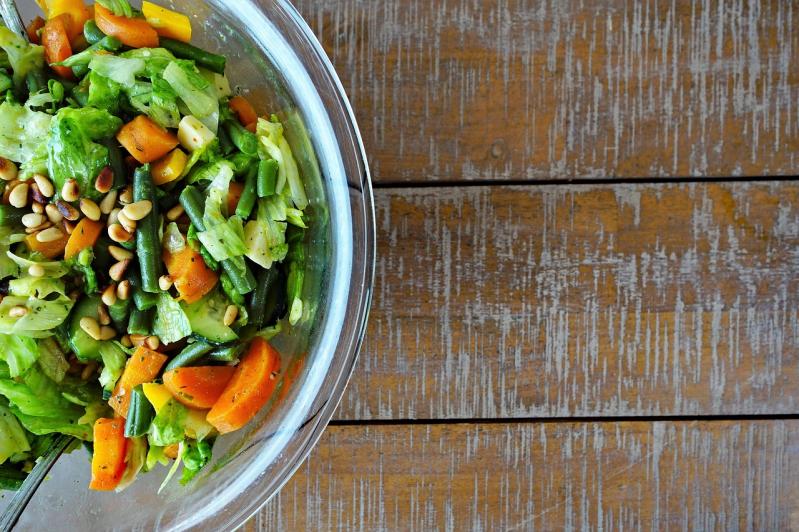Nuts are healthy, nuts are bad for you. Nuts are a superfood, nuts are fattening. It’s all true.
There is nothing better than a few sliced, toasted almonds in a Bibb lettuce salad with dill and a lemony dressing. Crushed peanuts in a spicy pad thai. Pine nuts on a baby spinach salad with oranges and feta cheese. Nuts offer texture, taste, and nutrition. A handful of cashews or almonds is a healthy snack, full of protein.
Nuts and seeds, such as pumpkin and sunflower, have been an important source of nourishment since prehistoric times. Walnuts, hazelnuts, chestnuts, and pine nuts all have both Old World and New World species because nut-bearing trees have been around longer than other food plants, long enough that they existed before North America and Europe split apart 60 million years ago. Humans have spread nut species to every region of the globe with a suitable climate. California is now the largest producer of almonds and walnuts, peanuts are grown throughout the sub- tropics, and coconuts grow throughout the tropics.
Unlike grains and some other legumes, nuts are delicious eaten in their dry, nutrient state or when toasted and crisped. They can be made into pastes, butters, oils, and milks. In many countries nut pastes are added to soups and stews to thicken them and add flavor. There are the almond soups of Spain, walnut soups of Mexico, and peanut soups of the American South. Tahini, the Middle Eastern sesame seed paste, is an essential ingredient for hummus and baba ganoush.
Some nuts, such as peanut, sunflower, and coconut, are used for making everyday cooking oils. Others such as walnut, hazelnut, and pistachio oil are intensely flavored and are used for salads.
Nut milks are made by soaking the nuts in water, then puréeing and straining them. In medieval Europe, almond milks and creams were luxurious ingredients and dairy substitutes for fasting days. Nowadays, they can be used to make ice creams and thicken sauces and are sometimes cooked into custards.
Almonds are the world’s largest tree-nut crop. Thanks to their high content of antioxidant vitamin E and low levels of polyunsaturated fats, they have a long shelf life. Almond paste, used to make marzipan, became so popular in Europe in the 1400s that Leonardo da Vinci was commissioned to make marzipan sculptures for the Milanese court of Ludovico Sforza. He wrote that he “observed with pain that they gobble up all the sculptures I give them, right to the last morsel.”
Brazil nuts are unusually large and contain the highest levels of selenium of any food. Two large Brazil nuts are the caloric equivalent of one egg. They grow in pods that weigh up to five pounds, so harvesters must wear helmets and shields to protect themselves from these falling missiles.
Chestnuts are different from other nuts in that they store their energy in the form of starch, not oil. They can be ground into flour and made into breads, cereals, and pastas. Before the arrival of potatoes and corn from the New World, chestnuts were an essential food in the mountainous regions of Italy and France.
Macadamia nuts are fairly new. They were introduced to Hawaii in the 1890s and became commercially significant around 1930. Australia and Hawaii are the main producers, and because of the rarity of these nuts, they are quite expensive. They have the highest fat content of tree nuts, and most of that fat is monounsaturated.
Peanuts are not technically nuts; they are seeds from a leguminous bush. Americans didn’t even eat peanuts until the 19th century. They were considered animal feed. India, China, and the United States are the largest peanut producers, and peanuts are used all over the world to make oils, butters, candies, and condiments.
Pecans are the soft, fatty seeds of huge trees related to walnuts. Native Americans made wild pecans into milk for cooking, and sometimes for fermenting into an alcoholic beverage. Georgia, Texas, and New Mexico are the largest producers today.
Pine nuts are gathered from about a dozen species of evergreen trees. They take three years to mature, then are sun dried, threshed from the pine cones, shaken, and hulled. No wonder they are so expensive. They have a distinctive, resinous aroma and are super rich in oils, as much as 78 percent. They can be used in sweet or savory dishes.
Pistachios are related to cashews and mangoes. They are remarkable among nuts because they contain chlorophyll, from being grown in cool climates at high elevations. Iran, Turkey, and California are the major producers today. Pistachios are used in patés and sausages, ice creams and other sweets. If you can ever find pistachio oil, buy it! It is the most beautiful emerald green, intensely flavored oil and you only need a few droplets on a plate to add flavor and color.
Because of their high oil content, most nuts can become rancid quickly. It is best to store oils in a cool, dark, place or even in the refrigerator. Nuts can be kept in airtight containers in the freezer for years. They will not develop ice crystals as they have almost no moisture.
We should all use nuts in everyday cooking. And a dish of cashews or pistachios for a cocktail party is always a hit. At various gourmet stores you can find walnut and hazelnut oils, which are delicious additions to salads. Just a few drops added to olive oil are enough.
When I make granola I add almonds, pumpkin seeds, sunflower seeds, sesame, and flax, all healthy . . . if a bit fattening. Try different kinds of nuts and see which you like the best. They are often more affordable bought in bulk at health food stores but be sure there is a high turnover, they can get stale quickly. Here are some of my favorite recipes featuring nuts.

